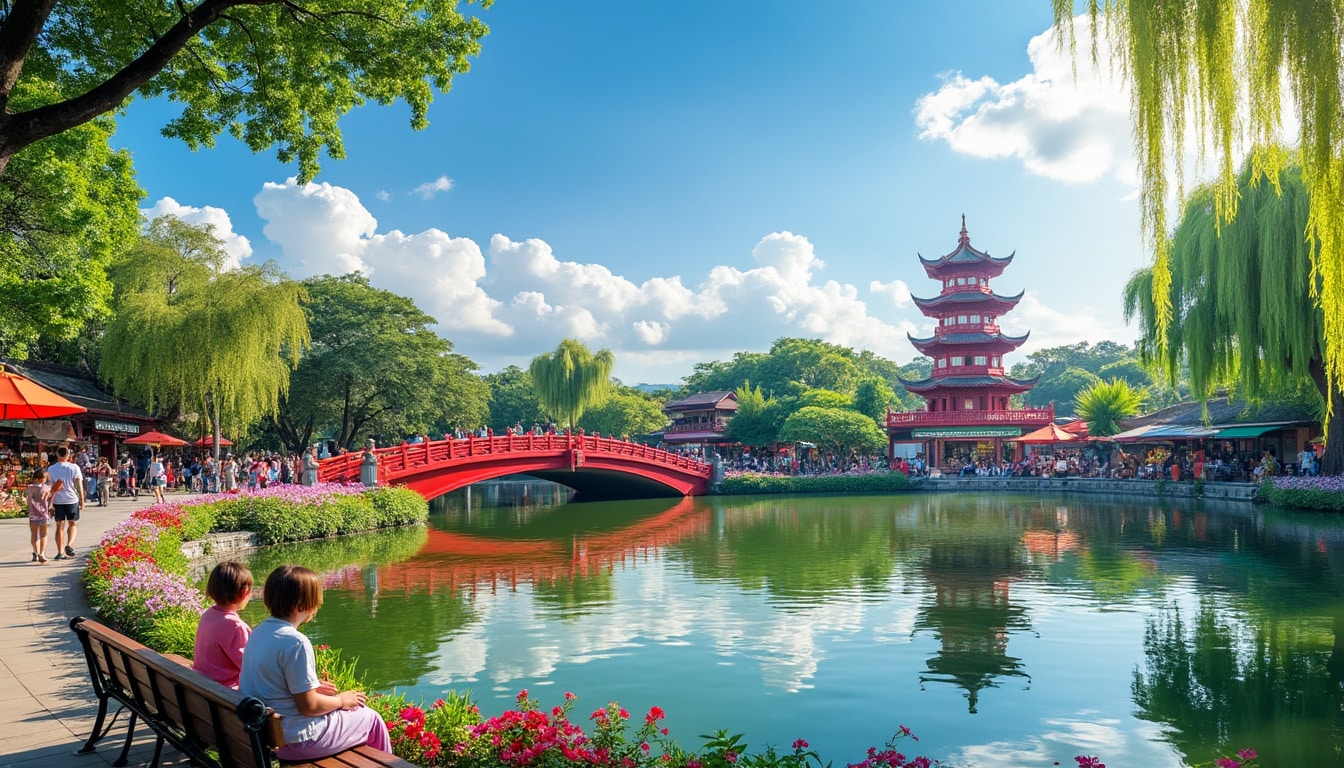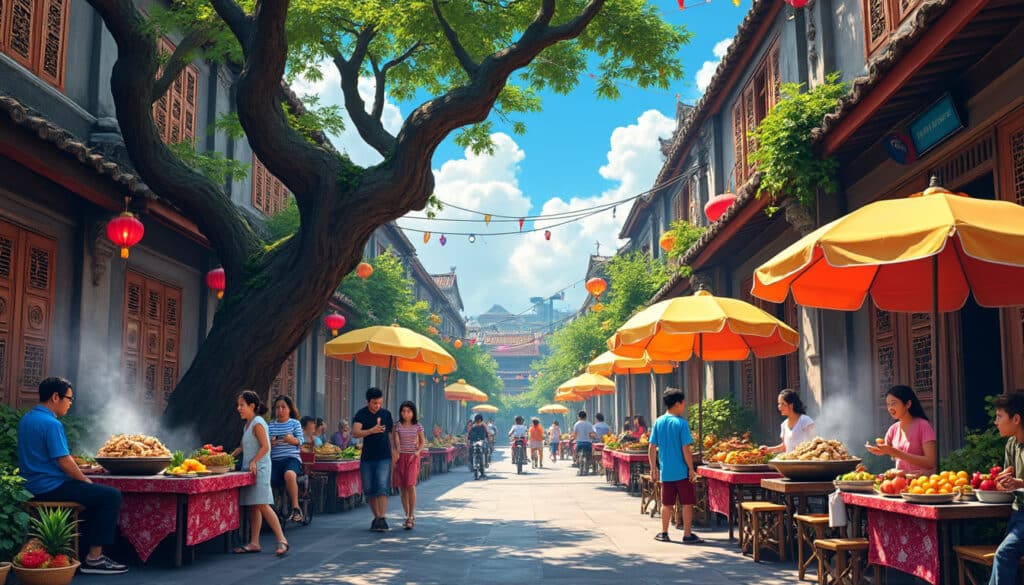Nestled in the northern region of Vietnam, Hanoi stands as a rich tapestry of stunning landscapes, a confluence of history and modernity, and vibrant cultural expressions. As the capital of this rapidly developing country, Hanoi offers not only historical depth but an ever-evolving urban landscape that attracts visitors from around the globe. From the serene beauty of its lakes and ancient temples to the lively streets bustling with motorbikes and aromatic street food, Hanoi enchants every traveler. Today, Vietnam Airlines and Bamboo Airways have made travel to this enchanting city more accessible than ever. As the city continues to evolve, one finds its heart in the Old Quarter, where tradition meets contemporary life. Let’s explore some fundamental aspects of Hanoi that make it a captivating destination.
The Enduring Legacy of Hanoi’s Historical Influence
Hanoi, a city whose spine embraces over a thousand years of history, serves as a living chronicle of Vietnam’s past. As the second-largest city in Vietnam, covering an impressive area of 3,358.6 square kilometers, Hanoi’s heritage is as vast as its physical expanse. Since becoming the capital of the Socialist Republic of Vietnam in 1976, the city has been pivotal in shaping the nation’s landscape. Its historical significance is recognized on a global scale, having been awarded the title of “City for Peace” by UNESCO in 1999, a testament to its efforts in promoting peace, equality, and cultural development.
One of Hanoi’s most prestigious accolades is its selection to UNESCO’s Creative Cities Network as a Design City in 2019. This acknowledgment highlights Hanoi’s commitment to fostering creativity, innovation, and sustainable urban development. The city’s creative pulse can be felt in its thriving art scene, from contemporary galleries nestled between French colonial buildings to the captivating performances at the Thang Long Water Puppet Theatre. Such institutions ensure that Hanoi’s reputation as a cultural powerhouse remains undiminished.
The capital’s historical identity is further embodied in its ancient structures. The Temple of Literature, established in 1076 as Vietnam’s first university, stands as a testament to the country’s long-standing academic traditions. Here, scholars once devoted themselves to the teachings of Confucius, and today, visitors can explore its tranquil gardens and stone steles, gaining insights into Vietnam’s educational past.
Another architectural marvel is the Hanoi Flag Tower, constructed in 1812, which serves not only as a military monument but also as a powerful emblem of the city’s enduring spirit and patriotism. The Long Bien Bridge, designed by the famous architect Alexandre Gustave Eiffel, is another engineering feat and a symbol of resilience, having withstood numerous wartime attacks. Both structures offer stunning views and are popular among locals and tourists alike, capturing the essence of a city that bridges its past with its present.
| Landmark | Year of Establishment | Significance |
|---|---|---|
| Temple of Literature | 1076 | First university in Vietnam |
| Hanoi Flag Tower | 1812 | Military monument |
| Long Bien Bridge | 1902 | Designed by Eiffel |

It’s not just the grand architectural feats that speak volumes of Hanoi’s history, but the legends that live on in its most beloved sites. The tale of Hoan Kiem Lake’s legendary turtle and the magical sword is woven into the very fabric of Hanoi’s cultural narrative. Such stories continue to captivate the imagination of visitors and residents alike, emphasizing the city’s role as a custodian of Vietnam’s rich folkloric traditions.
A Hub of Culture and Creativity in Hanoi
Hanoi’s cultural vitality is unmatched, with a vibrant arts scene that seamlessly blends traditional Vietnamese elements with modern influences. As a member of the Asian Network of Major Cities 21 and the C40 Cities Climate Leadership Group, Hanoi is at the forefront of cultural and environmental innovation. The city’s artistic expression can be seen in its stunning French Colonial Architecture, evident in landmarks such as the Hanoi Opera House and St. Joseph’s Cathedral. These structures echo the city’s colonial past, with elegant designs that add a European flair to the Vietnamese capital.
The Hanoi Ceramic Mosaic Mural, recognized as the world’s longest ceramic mural, is a proud symbol of the city’s artistic commitment. Spanning approximately 4 kilometers, this mural brightens the cityscape with vivid tiles that depict Vietnam’s rich cultural heritage and the dynamic spirit of its people. Projects like these are often supported by organizations such as VinGroup, which play a pivotal role in nurturing Hanoi’s cultural scene.
- 🌍 UNESCO Heritage Sites: Hanoi’s art scene includes contributions that are internationally recognized.
- 🎨 Diverse Art Galleries: Spaces like Duc Minh enthusiastically exhibit contemporary art. Discover more about Hanoi’s art scene
- 🖼️ Theaters and Performances: Venues like the Thang Long Water Puppet Theatre blend tradition with entertainment.
Hanoi’s position as a culinary capital also highlights its creative vigor. Renowned for its street food culture, each corner within the city offers unique flavors and dishes that have become emblematic of Vietnamese cuisine. From the iconic pho to the irresistible egg coffee, Hanoi’s street food is a sensory delight. Those looking to explore Hanoi’s flavors would do well to embark on a food tour, discovering gems like bun cha and cha ca la vong across its lively streets.
For visitors seeking the best dining experiences, Hanoi boasts an impressive range of eateries. From quaint local joints serving traditional dishes to upscale establishments offering innovative takes on classic recipes, there’s something to satisfy every palate. Explore the top culinary spots.
The Culinary Essence of Hanoi: A Feast for the Senses
The vibrant culinary scene of Hanoi is a reflection of its rich cultural heritage and dynamic street life. As Vietnam’s culinary capital, the city’s streets are alive with the tantalizing aromas of local dishes that embody the essence of Vietnamese cuisine. It’s a place where traditional meets modern, and every meal serves as a gateway to understanding the local culture.
Hanoi’s reputation as a food lover’s paradise is rightly earned. Famous for its street food, dishes like pho, bun cha, and cha ca have gained international acclaim. Hanoi’s egg coffee, a unique blend of robust coffee topped with creamy, sweet egg yolk foam, has captured the hearts and taste buds of locals and tourists alike. Dive into Hanoi’s iconic dishes.
Street food in Hanoi is not just about taste but an experience of the soul of the city. The best way to indulge is often at humble street stalls and family-run eateries where recipes have been passed down through generations. Learn more about Hanoi meal times and culture.
Dining in Hanoi is also about community. The act of gathering around a shared meal is a cherished tradition, reflective of the Vietnamese emphasis on family and connection. Locals and visitors alike are drawn together in the convivial atmosphere that pervades Hanoi’s dining spaces. Whether you’re sampling the delicate flavors of freshly made spring rolls or savoring a warm bowl of beef pho, each meal is a celebration of Hanoi’s culinary heritage.
| Dish | Key Ingredients | Popularity |
|---|---|---|
| Pho | Beef or chicken, rice noodles | Widely loved |
| Bun Cha | Grilled pork, vermicelli noodles | Very popular |
| Egg Coffee | Egg yolk, robusta coffee | A must-try |
For those interested in learning more about Hanoi’s linguistic diversity and how it contributes to the cultural melting pot, read more here.
Modern Hanoi: Architectural and Urban Development
Walking through the bustling streets of Hanoi provides a vivid picture of its architectural storytelling. The city’s skyline is an amalgamation of its historical and modern identity, defined by a blend of French colonial buildings and cutting-edge modern architecture. The charming narrow streets of the Old Quarter, home to many tube houses that are unusually tall and narrow due to property tax laws, illustrate the city’s evolution from tradition to modernity.
Hanoi’s architectural ingenuity doesn’t stop at its historical districts. Modern skyscrapers and expansive commercial zones like those developed by Lotte Hotels and other conglomerates demonstrate Hanoi’s rapid urban growth. These developments reflect a city poised for the future while remaining deeply connected to its historical roots. Explore more about Hanoi’s urban features.
The vibrant shopping destinations around Hanoi are indicative of the city’s economic vitality, drawing a steady stream of residents and tourists seeking a taste of both local craftsmanship and global brands. Notable areas like the VinGroup’s shopping complexes embody this unique blend of heritage and modern-day allure.
Throughout its urban landscape, Hanoi remains a city of lakes, offering serene respites amidst urban hustle. With over 100 lakes, including the well-known West Lake, this abundance of water bodies not only adds to the city’s scenic beauty but also serves recreational and ecological purposes. Touring these lakes can provide a tranquil counterbalance to the intensity of city life, a side of Hanoi that’s best appreciated at a leisurely pace.
- 🌊 West Lake: A popular spot for activities and dining.
- 🛍️ Old Quarter: Perfect for finding unique souvenirs and bustling markets. Discover the best shopping spots in Hanoi
- 🏢 Modern Skyscrapers: Reflecting economic growth and modernity.
It’s this juxtaposition of old and new that makes discovering Hanoi’s urban environment so rewarding — a place where every street tells a different part of its story.
Hanoi’s Role on the Global Stage: Connectivity and Influence
The global recognition of Hanoi is further validated by its strategic position as part of the Maritime Silk Road. This historical trade route has shaped Hanoi’s role in global commerce and cultural exchanges, emphasizing its connectivity. As a result, Hanoi has established sister city relationships with major cities around the world including Bangkok, Seoul, and Paris, creating a network of goodwill and cultural exchange.
Hanoi’s participation in global initiatives, including the Asian Network of Major Cities 21 and the C40 Cities Climate Leadership Group, underscores its commitment to playing an integral role in addressing global challenges, from environmental sustainability to cultural heritage protection.
These initiatives, alongside Hanoi’s diverse bilingual education programs, enhance its regional influence, making the city not only a hub of cultural innovation but also an agent of positive global change.
As Hanoi continues to expand its global footprint, aided by Vietnam Airlines and other international partners, it remains a beacon of resilience, innovation, and cultural richness — attributes that have defined its character throughout history.
Victory through Resilience: Hanoi’s Historical Trials
Hanoi’s historical trajectory is marked by resilience, a characteristic visible in triumphs over adversity. Throughout its storied past, the city has faced invasions, colonial rule, and wartime challenges, each leaving indelible marks on its identity. The Hanoi Hilton, or Hỏa Lò Prison, serves as a reminder of these struggles, having been originally used by French colonists and later by North Vietnamese forces during the Vietnam War. Today, it stands as a museum, capturing the endurance of its people.
Perhaps the most poignant symbol of Hanoi’s wartime resilience is the B-52 wreckage site, where remnants of a bomber shot down during the Vietnam War serve as a stark memorial to the conflict. These historical touchpoints not only educate but resonate deeply with visitors, urging reflection on the themes of resilience and peace.
Hanoi’s cultural festivals further reinforce the city’s indomitable spirit, from the vibrant Tet Festival marking the Lunar New Year to smaller traditional celebrations that dot the cultural calendar. Each festival is a testament to Hanoi’s ability to thrive amidst adversity, showcasing its rich heritage and fostering community spirit.
This enduring legacy of resilience continues to inspire both residents and visitors, offering a narrative of hope and strength that echoes through the vibrant streets of Hanoi.
Frequently Asked Questions About Hanoi
- What is Hanoi best known for? Hanoi is best known for its rich history, stunning architecture, vibrant street food, and traditional Vietnamese culture.
- When is the best time to visit Hanoi? The best time to visit Hanoi is during the spring (March to April) and autumn (September to November) when the weather is mild and pleasant.
- What are some must-try foods in Hanoi? Must-try foods include pho, egg coffee, bun cha, and cha ca. These dishes capture the essence of Hanoi’s culinary landscape.
- How can I experience local culture in Hanoi? To experience local culture, visit lakeside markets, enjoy a water puppet show, and explore the Old Quarter for a glimpse into daily life.
- What transportation options are available in Hanoi? Hanoi offers various transportation options including buses, taxis, motorbikes, and the new metro system being developed for easier city navigation.
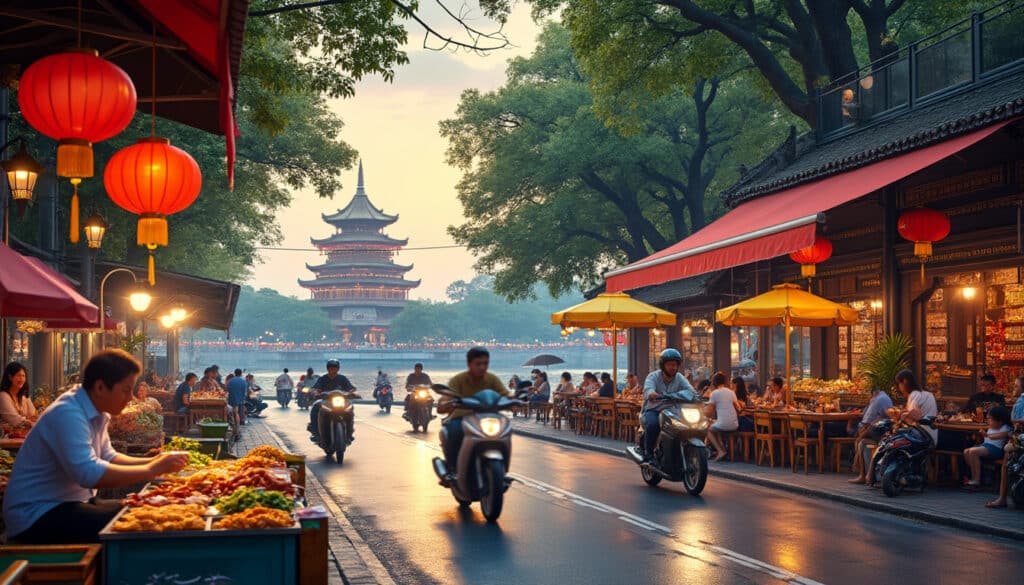
Fun Facts & Curiosities About Hanoi
Hanoi, the vibrant capital of Vietnam, is a fascinating mix of rich history, unique traditions, and modern progression. From its celebrated street food scene to the captivating water puppet shows, Hanoi is both a city of lakes and legends. Visitors…
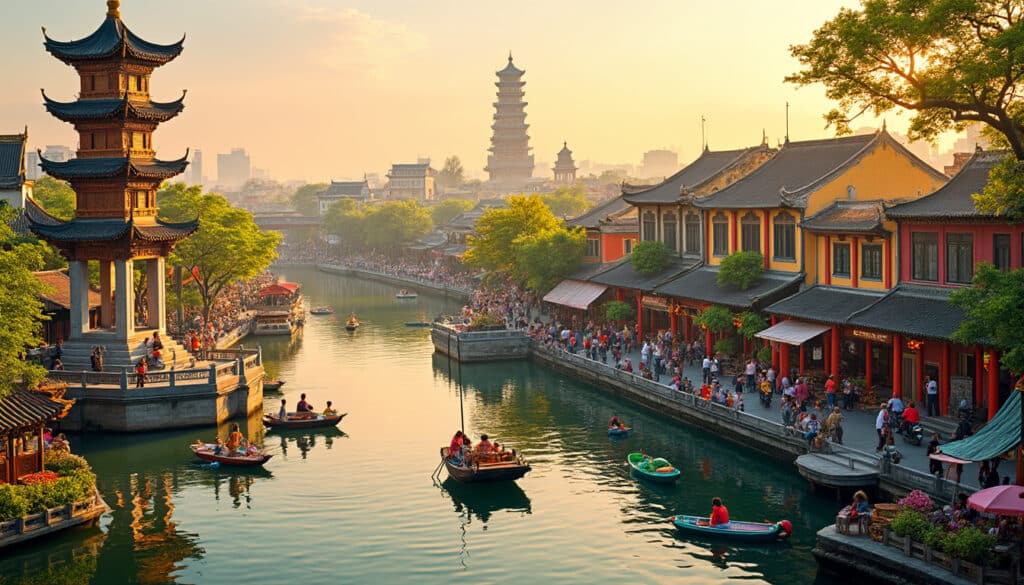
Architecture and urban features of Hanoi
With a rich tapestry of cultures and historical evolution, Hanoi stands as a captivating testament to Vietnam’s architectural diversity. This city’s allure doesn’t just lie in its remarkable history but in its unique blend of oriental and French-style architecture that…
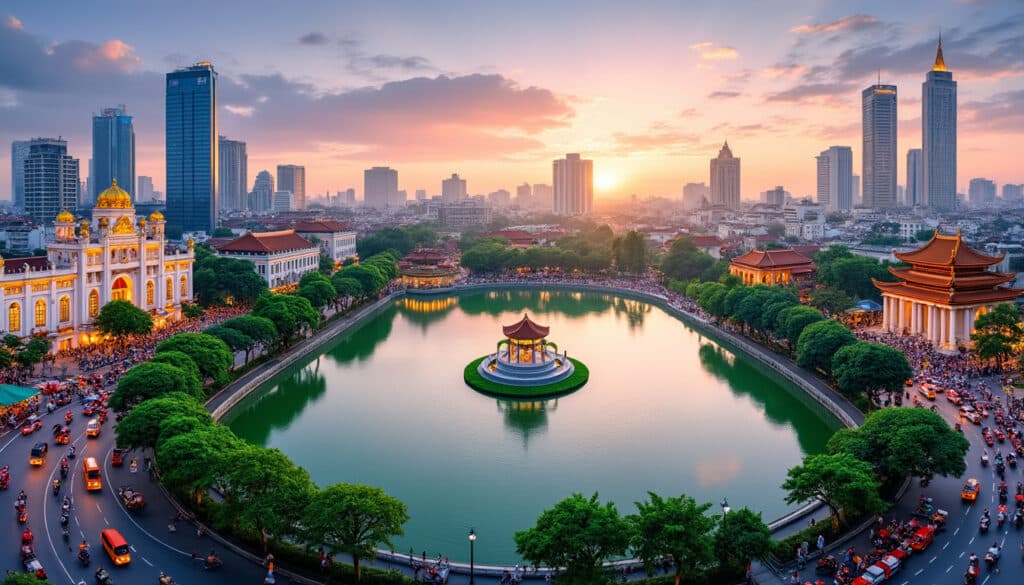
Demographics and geography of Hanoi
The vibrant city of Hanoi, the capital of Vietnam, is not just the political heart but also a pulsating hub of culture, history, and modernity. With a rich tapestry of over a thousand years of evolution, the city has seen…
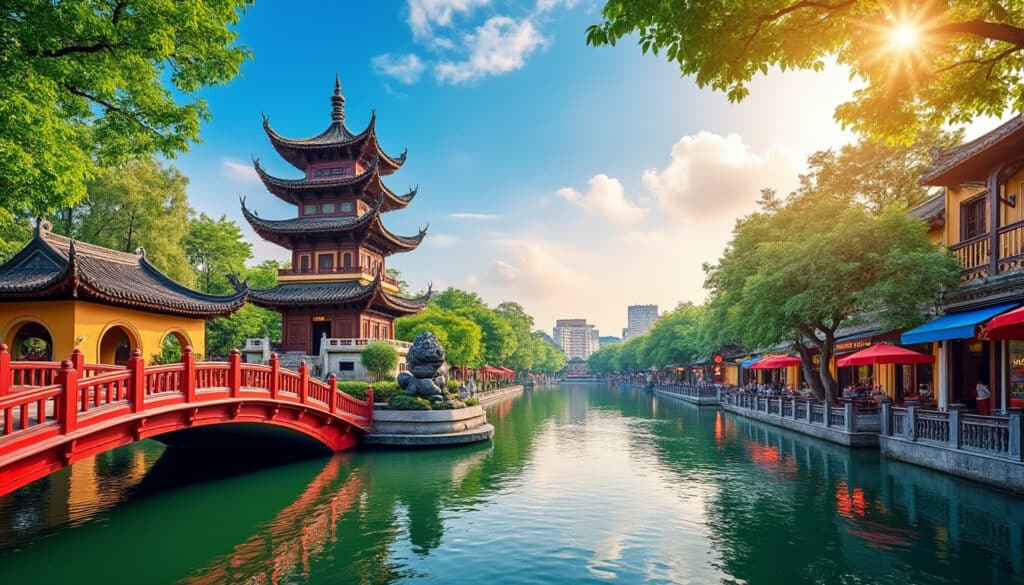
Welcome to Hanoi, Vietnam’s enthralling capital, where the echoes of ancient history resonate through its vibrant streets. With over a millennium of culture and conquest, Hanoi is a city where the past seamlessly intertwines with modernity. From bustling street markets…

Holidays and celebrations in Hanoi
Hanoi, the pulsating heart of Vietnam, offers a tapestry of vibrant festivals and celebrations that reflect its rich cultural heritage and traditions. Throughout the year, local and international visitors witness an enchanting blend of the past and present, as the…

Language and spelling of Hanoi
Hanoi, the vibrant capital of Vietnam, is a melting pot of cultures, histories, and languages. It’s not just a city known for its charming architecture or vibrant street life, but also for its linguistic diversity that reflects its historical tapestry.…

Local tips for tourists in Hanoi
Exploring Hanoi, Vietnam’s thousand-year-old capital, is a journey into a world where ancient traditions and modern dynamism converge. With its rich cultural heritage, vibrant street life, and aromatic cuisine, Hanoi captivates every traveler. Yet, navigating this bustling city can be…

Names, flags, and identity of Hanoi
In the heart of Vietnam, Hanoi stands as a testament to the cultural and historical richness that has evolved over millennia. The names, flags, and identity of this vibrant city are not just labels or symbols, but threads woven into…

Reputation and identity of Hanoi
As the capital city of Vietnam, Hanoi’s reputation and identity intertwine richly with its historical and cultural legacies. Emblematic for its historic architecture, street food, and melodious water puppet shows, the city pulsates with the quintessential Vietnamese spirit. From its…

As the vibrant capital of Vietnam, Hanoi is a city that offers an intriguing blend of history, modernity, and cultural diversity. Understanding the rhythm of this bustling metropolis goes beyond its rich traditions and lively street scenes. The way time…

Unusual facts and social issues in Hanoi
Hanoi, the bustling capital of Vietnam, is a city that fuses ancient traditions with rapid modernity. Known for its rich cultural heritage, Hanoi’s unique blend of history and progression offers a fascinating backdrop for unusual facts and social dynamics that…
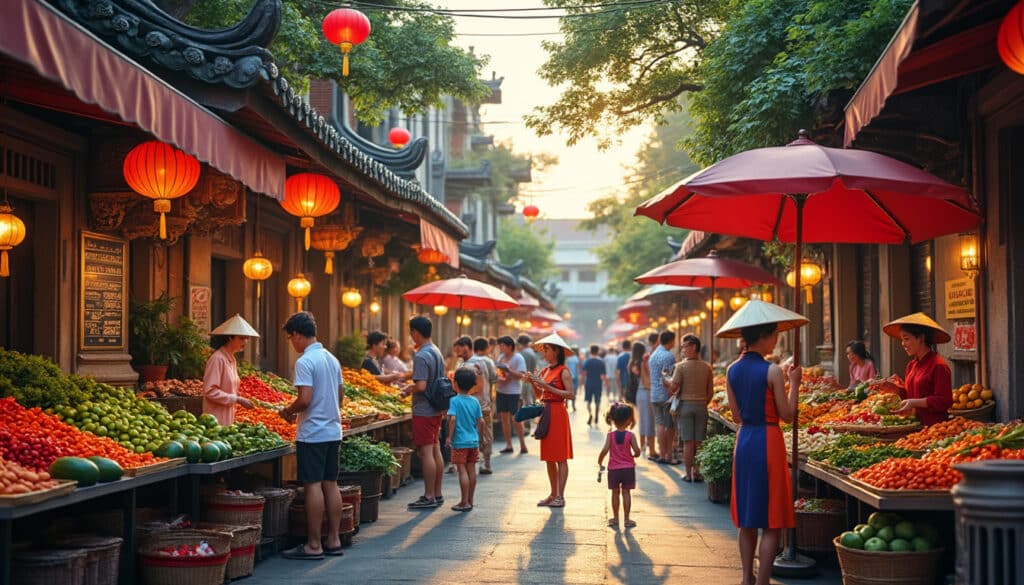
What does Hanoi look, smell, feel like?
Experiencing Hanoi is like stepping into a symphony of vibrant images, lively sounds, and delightful scents. Nestled between historic roots and modern hustle, Vietnam’s capital offers a unique sensory journey. Whether you’re wandering through the alleys brimming with local art…

